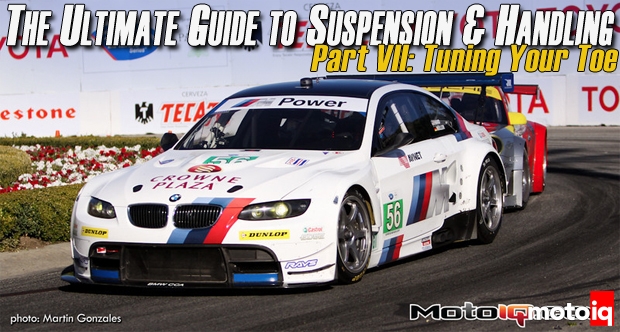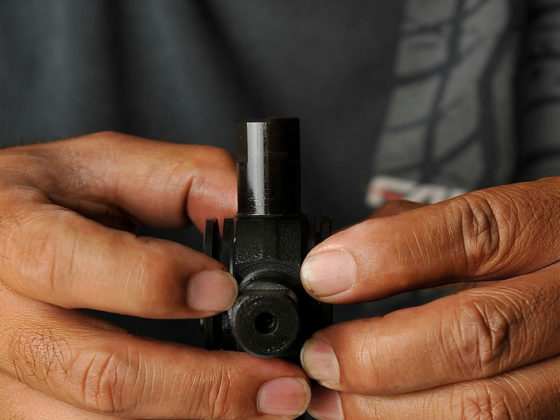,
 |
| Toe plates are handy for quick toe checks on the fly. They are simple and easy to use. |
Too much toe-in or out:
• Causes tire wear on the outside and inside edges of the tire respectively. Toe can ruin a tire very quickly.
• Any toe setting past 1/8″ of an inch either way has a very negative effect on tire life in street driving.
• Too much toe has probably ruined more tires on lowered cars than any other single attribute.
• Anytime you use more than ¼” of toe, you are risking getting into the too much zone, proceed with caution.
 |
| Smart strings are super accurate and are used to set the toe on all 4 wheels at once off of a common datum plane. |
Every car is adjustable for front toe through the steering tie rod ends. All multilink cars are adjustable for toe front and rear. Cars that are live or beam rear axle usually must have the axle or axle-housing bent to adjust toe by an experienced chassis shop although some can be adjusted with wedge type shims under the hub carriers.
 |
| Front toe is adjusted by turning the turnbuckle on the front tie rods. All cars are like this. On Mike Essa’s BMW drift car it is the red rod shown here. |
 |
| Rear toe adjustment is different on various cars. On Mike Essa’s car it is adjusted through turning the turnbuckles on this blue link. |
Below are some typical toe adjustments for different cars, tire wear expectations and styles of driving.*
| Driving Use |
FWD/ AWD |
RWD |
FWD/AWD |
RWD |
|
Aggressive Street Driver |
Front 0 |
Front 0 to 1/16” in |
Rear 0 |
Rear 1/8” in |
| Weekend Hot Lapper | Front 0-1/8” out | Front 0 to 1/8” out | Rear 0-1/8” out | Rear 1/8” in |
| Racer Only/ Serious Autocross/ Serious Drifter | Front 1/8-1/4” out | Front 0 to ¼” out | Rear 0-1/4” out | Rear 0-1/4” in |
*The Nissan GTR and GT-R uses alignment settings more like a RWD car instead of an AWD car as it behaves more like a RWD.
 |
| Costa Gialamas uses Smart Strings to set up Matt Powers’ car at Formula D Long Beach. Smart Strings are highly portable and easy to use in the field. |
Since toe is easy to adjust, we suggest you use the above as a rough guideline and experiment to tune your chassis to your preference.




9 comments
Practical tip: after using toe plates double check your work by placing a toe plate on the front and rear wheel on the same side of the car with the steering wheel pointed straight ahead. Lie on the ground and sight along the toe plates. Do the same on the opposite side of the car. This will show up any large errors in your toe plate alignment. It’s easy to turn a turnbuckle in the wrong direction and not notice if you skip this step. Also, be aware that changes in camber may or may not change toe. And ride height changes can affect camber and toe. So after lowering your car off the jackstands you need to bounce it at all four corners or drive it a short distance to make sure the suspension has settled back to its normal ride height. This last step is especially important if you have poly bushings which tend to have some initial resistance to rotation (hint: poly bushings occasionally need to be taken apart and greased). One last tip: On your street car if you see feathering on your tires (tread blocks wear into a wedge shape) you have a toe problem. On your track car if you have tire chunking (pieces of tread break off the tire carcass) you may have a toe problem.
when you refer to 1/8 or 1/4inch adjustments are you talking about just one side or the total amount of both left and right wheels?
Total
Hey Mike!
I was reading your The Ultimate Guide to Suspension and Handling for like three years without racing just dreaming of racing some day.
This year was my first year of ice racing. And damn! The difference correct toe tuning makes!
Just wanted to say how greatful I am for the guides.
Thanks mate!
Another thank you for Mike from me.
After reducing front toe-in to the minimum the equipment could register (0.03degrees each side) and reducing the rear toe-in (0.06 degrees each) and camber (from 2.6 to 2.0 degrees) and nothing else, cornering G went from 0.8 to 1.0 on winter tyres. 0.8 was ok, but 1.0 is excellent for a street setup and i can keep the car there as long as the turn lasts. Above 1.0G understeer sets in but I think a slight increase in track width, caster and SAI might raise that.
On good summer tyres the limit is higher but cant tell how high yet. With 215/50r17 Hankook Ventus prime2 on the rear and 225/45r17 Hankook ventus v12 evo2 up front the rear stepped out at 1.05G. Ordered wider wheels and 4 235/45r17 tyres, will see where we are after lockdown, but 1.15G or above i suspect.
Just wanted to share those numbers for people who are wondering how much differernce toe can make, though the reduced camber in the back will also have helped to make the car turn.
Hi from halfway across the world, Mike. I’m a big fan of your articles and this series in particular. What are your thoughts about using toe out to counter the toe in moment/effect caused by negative camber thrust? Assuming we don’t care about tire wear, of course.
Hope to hear from you soon. Cheers
Chez
Yes, that is one of the reasons why you do toe out.
Mike, thanks so much for all the great information, you’ve helped me drop seconds off my lap times.
I was wondering if the toe recommendations listed are total toe or per side?
Total toe in.